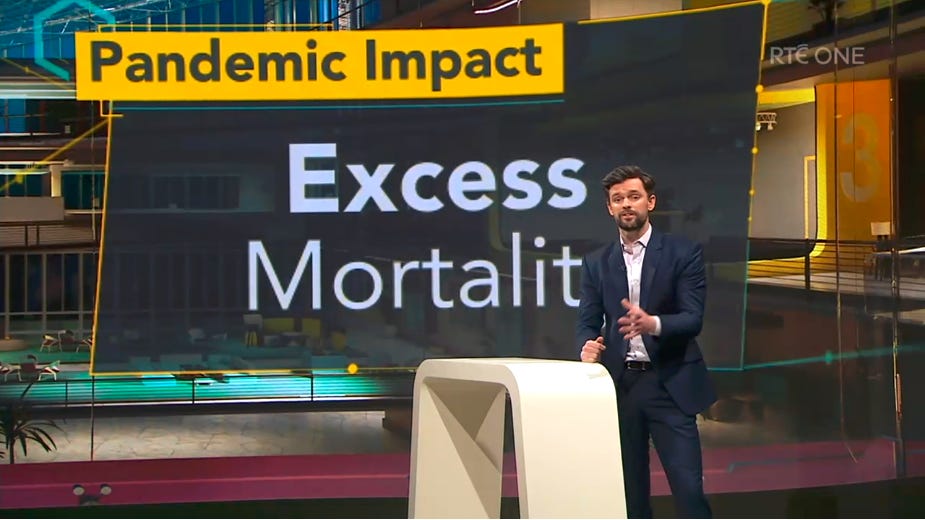Recapping: Government Reports & Talking Points (Official Take)
A Nation Grows Older (part 6) - Recapping

After much dithering and dallying, and mere weeks before calling a general election, the Irish Government finally initiated a long-promised and much-needed inquiry into its pandemic response1. However, it won’t be an official statutory inquiry with legal powers, but a weak tea “comprehensive evaluation” having no powers to compel attendance or testimony from witnesses, nor will it be able to compel provision of any other documentary evidence. Indeed, Irish officials have long been at pains to emphasise nobody will be blamed2 (for anything, apparently). Pardon?
Ultimately the final analysis of deaths associated with this pandemic will depend on excess mortality monitoring.
- Department of Health Paper discussed by NPHET (28th May, 2020)
The announced scope of the comprehensive evaluation includes:
“Impacts, both immediate and longer term, on individuals, families and communities of non-pharmaceutical interventions (NPIs) and the Government’s response to managing and mitigating risks of the disease…”.
One aspect expected to be evaluated will inevitably be the mortality impact and the issue of excess mortality. This post provides an overview of the official public position on estimates of Ireland’s excess mortality during the pandemic with a follow-up post looking at the basis upon which updated estimates will likely be made.

All-Cause Excess Mortality
Publicly released minutes of Ireland’s National Public Health Emergency Team (NPHET) from a meeting 28 May 20203 reveal a paper was to be submitted to the Minister of Health (Simon Harris at the time) stating excess all-cause mortality was the best way to estimate the overall mortality impact of the pandemic. The paper, “COVID-19: Comparison of Mortality Rates between Ireland and other countries in EU and Internationally4”, authored by members of NPHET5 for the Department of Health (DoH) show acute awareness that deaths could arise both directly and indirectly from the corona virus disease and the surrounding social or public health response [emphasis by Witzbold]:
“Comparing all-cause mortality during the COVID-19 pandemic to deaths that have happened in previous years in the same weeks or months (“excess mortality”) is the best way to estimate the mortality impact of COVID-19. All-cause death is an important index to monitor during any pandemic as COVID-19 (like influenza) is expected to give rise to direct and indirect mortality. Therefore, we would also expect to see an increase in deaths from other causes such as strokes, myocardial infarction etc. Excess deaths from the coronavirus disease 2019 (COVID-19) pandemic might arise both in those infected (direct effects), as well as those affected (indirectly, not infected) by altered access to health services; the physical, psychological, and social effects of distancing; and economic changes”.

Bizarrely, the NPHET minutes of the discussion of this paper could claim, “…Ireland has been in a position to report comprehensively on mortality, often before other countries.”, despite NPHET already (April 7th) identifying the protracted deaths registration process in Ireland as an issue and discussing amending legislation to reintroduce the pre-2005 registration requirement of within one week.
The NPHET paper for the DoH goes on to state:
”However, calculation of excess mortality is contingent upon timely death notification data and in Ireland we have a relatively long period before families are legally required to register a death of up to 3 months. Most other EU countries have a shorter period of usually less than a week during which deaths must be registered.”
Indeed, discussed in the paper were early attempts to analyse public death notices (at RIP.ie) as a proxy for more complete and near real-time death figures [emphasis by Witzbold]:
“In the absence of timely registration data, the Health Information and Quality Authority (HIQA) have looked at death notices on the RIP.ie site. …the excess mortality observed on rip.ie was less than the reported Covid-19 related mortality over this period.”
The HIQA’s own report, “Excess all-cause mortality in Ireland during the COVID-19 epidemic”, would not be officially published until July 2020, but its results were already being discussed by NPHET. The HIQA press release (3 July 2020) would state clearly [emphasis by Witzbold]:
HIQA found that the officially-reported COVID-19 deaths likely overestimates the true burden of excess deaths caused by the virus. This could be due to the inclusion within official figures of people who were infected with SARS-CoV-2 (coronavirus) at the time of death whose cause of death may have been predominantly due to other factors.
Indeed, RTÉ prominently covered HIQA’s findings in July with genuine surprise that estimated all-cause excess mortality (1,100~1,200) was “substantially” less than numbers of Covid-related reported deaths(~1,700) for the same period6 . The conclusion of the Department of Health paper discussed by NPHET made the significance of all-cause excess mortality starkly clear: [Witzbold’s emphasis]:
Conclusion
One of the most important ways to measure the burden of COVID-19 is mortality. Ultimately the final analysis of deaths associated with this pandemic will depend on excess mortality monitoring. It is also possible that some of the excess mortality currently observed in the very elderly impacted by this virus may be followed by a period of decreased mortality.
Government Info
Official Ireland was thus fully informed of the most important factors around the mortality impact of the pandemic when it came to discussion and presentation of death figures:
Excess pandemic deaths could arise both in those directly infected, as well as those indirectly affected (altered access to health services; physical, psychological, and social effects of distancing; economic changes; etc.)
Officially-reported Covid-19 deaths substantially overestimated the true burden of excess deaths caused by the virus
All-cause excess mortality is ultimately the best way to estimate the mortality impact of the Covid pandemic
Official all-cause death figures in Ireland are significantly incomplete, and significantly delayed (NPHET advocated amending legislation to reintroduce pre-2005 registration requirement of within one week)
Public death notices provided a near real-time proxy (albeit still incomplete) of trends in death totals.
Government Talking Points
Perhaps unbeknownst to many still calling for a full inquiry, in January 2022 the government had already approved a Public Health Reform Expert Advisory Group (PHREAG) which was requested to examine the public health response to Covid-19 for the period to date, i.e. 2020-2021.
Report of the Public Health Reform Expert Advisory Group
This report was first presented to government on 6 September 20237. Under the heading, “What worked well?”, the topic of excess mortality was highlighted: “Ireland has performed relatively well in response to COVID-19 to date.
…with excess mortality amongst the lowest in Europe, and globally.”
The respective footnotes reveal the basis for these dual claims of excess mortality being amongst the lowest in Europe, and globally as:
19 - “Descriptive analysis of COVID-19 epidemiological indicators and associated contextual factors in European countries”, an analysis produced by Health Information and Quality Authority’s (HIQA) COVID-19 Evidence Synthesis Team, and published in April 2022
20 - “Estimating excess mortality due to the COVID-19 pandemic: a systematic analysis of COVID-19-related mortality, 2020–21”, a paper published in the Lancet in March 2022
The World Health Organization (WHO) would not declare an end to the global Public Health Emergency (PHE) for Covid-19 until May 2023. Significantly, 2022 proceeded to be the year of worst excess mortality in Ireland, surpassing that of both prior pandemic years 2020 and 2021. Nevertheless, the excess mortality of 2022 remained outside the official scope of the Public Health Reform Expert Advisory Group’s (PHREAG) report and consequently went unmentioned.
Lancet Paper
This ambitious paper published May 2022 has since been the favoured point of reference for Irish Government officials when addressing the issue of excess deaths, e.g. Stephen Donnnelly (Minister of Health), Micheál Martin (Taoiseach), Simon Harris (current Taoiseach, former Minister of Health) . The authors seem to have used monthly figures of public death notices for 2020-21 from RIP.ie “cleaned” (processed) by the Irish Central Statistics Office8, and official CSO monthly death figures for 2015-19 as the basis of its modelling-heavy estimates of excess deaths.
The Lancet authors estimated Ireland’s excess deaths for 2020-2021 were 1,170 with a large uncertainty interval of 84 to 2330, i.e. ranging from effectively none up to a statistically significant ~3.5%.

None of the figures listed in the Lancet’s table9 (excerpted above) of estimates offer a meaningful basis for international comparison because the so-called crude rate (per 100,000) takes no account of demographic specifics of individual countries, nor is the estimated base rate of expected annual deaths provided. For example, because the age structure of Ireland’s population is the more or less the youngest in Western and Northern Europe, it should be expected to have one of the lowest crude rates of death. Due to the inconsistent designation of Covid-19 deaths across various countries, the Covid-19 death figures and mortality rates are similarly unsuitable for comparison.
It seems PHREAG nevertheless rested its reported findings on the following key sentence of the Lancet paper [Witzbold’s emphasis]:
Rates varied substantially in western Europe; some countries had rates nearly as high as the locations listed previously, while others, such as Iceland, Norway, Ireland, and Cyprus, had some of the lowest rates in the world, at less than 50 deaths per 100 000.
2nd HIQA Report
This report was undertaken by HIQA’s Covid-19 Evidence Synthesis Team at the request of the Department of Health in early 2022:
“…focuses on the time period from the beginning of the COVID-19 pandemic up to the emergence of the Omicron variant in Ireland (that is, from 1 January 2020 up to 30 November 2021).”
The analysis of excess mortality was however provided in turn by Ireland’s Health Protection Surveillance Centre (HPSC) and based on incomplete death registration data processed using an algorithm developed by EuroMOMO.
HPSC analysis, like the first HIQA report, does not explicitly take account of Ireland’s demographic structure but applies time series modelling based on historical data and trends in previous years. HPSC estimated a total of 2,019 excess deaths occurred in Ireland between start of March 2020 and end of November 2021 (excluding “…352 excess deaths were estimated to have occurred in January and February 2020”).
Again, this was substantially less than the ~5,500 “confirmed” Covid-19 deaths reported by the HPSC in its weekly bulletin for the same period10 (approximately ~10% of total deaths).
Making sure to emphasise the majority of excess deaths were in the older age groups (in which the majority of deaths always occur) the excess deaths total (March 2020 - Nov 2021) is broken down further by HIQA into to three broad age-groups:
The majority (82%) of excess deaths in Ireland occurred among those aged 65 years and older (n=1,665), with 22% of all-cause excess deaths in Ireland occurring in those aged 85 years and older (n=451).
This equates to:
Ages (0-64): 354 excess deaths, or ~3% excess (2-year baseline ~12,000)
Ages (65-84): 1,214 excess deaths, or ~4% excess (2-year baseline ~32,000)
Ages (85 years+): 451 excess deaths, or ~2% excess (2-year baseline ~23,000)
Needless to say, both the HIQA and the PHREAG report authors neglected to highlight the counter-intuitive disproportionality of excess mortality in the different age groups as indicated by the HPSC’s figures.
Aside:
HPSC also reports the average of reported Covid-19 deaths in Ireland at 82 years of age with a median age of 85 (without ever citing the respective median ages for all-cause mortality, which are closer to ~75 and ~80). In other words, while Covid-19 deaths have been widely reported as disproportionately affecting the oldestage, with respect to base rates of all-cause mortality, all-cause excess mortality has counter-intuitively NOT affected the oldest in Ireland disproportionately more.
As mentioned in the Lancet paper (and all of the reports covered within this post), reported Covid-19 deaths consistently exceed estimated all-cause mortality. This is primarily because of the critical distinction between “died with” and “died of” Covid-19 with reported Covid deaths most often occurring in the older age groups an, i.e. those with multiple pre-existing co-morbidities.
Similarly, PHREAG authors reported no contradiction between the HPSC analysis finding almost twice the number of excess deaths (within a briefer truncated period) as the Lancet paper (albeit at the extreme of its uncertainty interval). Most curiously, the PHREAG report ignored HIQA’s Covid-19 Evidence Synthesis Team stating explicitly, “…direct comparison of z-scores, is limited in its validity. As such, comparisons are not made in this report between Ireland and any one country.”
Remember, this HIQA report is cited as basis of claims in the Public Health Reform Expert Advisory Group’s report of September 2023 that Ireland’s excess mortality was amongst the lowest in Europe. It seems PHREAG authors again latched on to a sentence in the results and conclusions of the HIQA report, about a very limited period from mid-2021 to late-2021 (i.e. a truncated period excluding both the initial spring and winter waves)[Witzbold’s emphasis]:
Between mid- and late-2021, some countries experienced a peak in excess mortality while Ireland did not. During this time, the excess mortality in Ireland was observed to be amongst the lowest in Europe.
In fact, Ireland subsequently experienced its peak in excess mortality in 2022 while many other countries did not. However the PHREAG report does not even address 2022 and the authors (or perhaps the Irish Government) gratuitously generalised a statement about mid- to late-2021 to one seemingly about the whole pandemic in its conclusions:
While the cumulative case rate in Ireland was in line with the EU27 average, surges in hospitalisations were of a lower and shorter duration than those experienced by many European countries, with excess mortality amongst the lowest in Europe, and globally.
Meanwhile, the recent Expert Steering Group’s (ESG) Report of the Emerging Health Threats Function published 25 October 2024 by the Department of Health simply parroted the findings of the earlier PHREAG report and offers no further sources or analyses of years since 2021.
Exaggerated claims based on inconclusive data is a repeating pattern with Irish Government departments and officials.
- Witzbold
Two further estimates of excess mortality in Ireland for pandemic years 2020 and 2021, which have been heavily promoted by the Irish Government, were produced by the OECD and the Society of Actuaries of Ireland in 2023 and 2024 respectively. Both of these analyses have been covered in detail in previous posts at Witzbold’s Newsletter here and here.
OECD Working Paper
Entitled “Examining recent mortality trends – the impact of demographic change” (published 17 November 2023), the figures for Ireland were based on provisional deaths registration data and estimated Ireland experienced no cumulative excess mortality during the 3-year period 2020-22 (once adjusted for demographic change, and compared with a baseline of the average in 2015-19). The Department of Health and Chief Medical Officer, gleefully overlooked the glaring contradiction between the OECD paper’s finding and that of the HPSC figures cited in the PHREAG report published by the DoH a mere two months earlier. At the very least, the OECD paper highlighted for official Ireland the importance of considering variations in demographic structure when estimating excess mortality.
Society of Actuaries of Ireland Report
This paper, published in June 2024, was based on official CSO annual deaths figures up to 2021. Similarly to the OECD paper, it took account of changing demographics, but counter-intuively (for an actuarial approach), again failed to account for long-term trends of falling mortality rates and increasing life expectancy in Ireland11. It found effectively no overall excess mortality in 2020 (against an age-standardised baseline of the 2017-19 average), and approximately 1,000 (approximately ~3%) excess deaths in 2021, thus arriving at a similar overall figure to the Lancet paper published two years previously. This was further music to the Department of Health’s ears.

Remarably, the SAI report’s figures (see table above) suggested the percentage excess mortality in the 0-64 group was highest once expressed as a percentage of the expected number (a so-called P-Score). Its figures also indicated, the ages 65-84 effectively experienced zero excess mortality. The authors made sure to trivialise these counter-intuitive and inconvenient results. Again, the Department of Health and Irish Government had no qualms touting a paper based on such unrealistic assumptions.
Summary
On the basis of the above four reports, Irish officials and a dutiful mainstream media have unconvincingly claimed excess deaths in Ireland 2020-21 ranged from OECD's less than zero (meaning less people died than expected!) to HPSC's ~2,350 (corresponding to approximately ~3.5% more deaths than expected). Contradictorily, HPSC had been reporting “confirmed” Covid-19 deaths accounted for ~10% of all deaths.
Conclusion
While readers may be skeptical of any or all such estimates, it is important to at least recognise how official Ireland regards this topic. Keep in mind death figures did rise substantially in 2020-21 (especially April ‘20 and Jan ‘21) but overall (cumulatively) not excessively so, once considering long-term mortality trends and by international comparison are considered. However, the worst years of excess mortality in Ireland were yet to come: 2022-23.
A follow-up post will present Witzbold’s updated estimates of excess mortality based on latest official CSO and Eurostat data and projections.
Government press release
https://www.gov.ie/en/press-release/924d6-government-appoints-chair-and-agrees-terms-of-reference-for-evaluation-of-the-response-to-the-covid-19-pandemic/
Taoiseach Leo Varadkar and Tánaiste Micheál Martin both said that while Ireland’s performance during the pandemic must be probed, it cannot be a “blame game”.
https://www.irishmirror.ie/news/irish-news/politics/covid-ireland-government-planning-non-31969589
NPHET minutes 28 May 2020
https://assets.gov.ie/75862/6d0d5618-d5da-43db-9d5f-29ef4d8092e0.pdf
NPHET Comparison of Mortality Rates between Ireland and other countries in EU and Internationally
https://assets.gov.ie/75031/2c4aee04-baca-4b12-90a0-e999621b82e5.pdf
See draft from 27 May 2020 initialed EC - Eibhilin Connolly, DOF - Darina O’Flanagan, BS - Breda Smyth
https://assets.gov.ie/75011/b52b39d7-7472-4902-b36b-9ab3909cf5a8.pdf
RTÉ: Excess deaths 'substantially' less than Covid-19 figures - HIQA
https://www.rte.ie/news/health/2020/0703/1151127-virus-report/
Publication by Public Health Reform Expert Advisory Group
https://www.gov.ie/en/publication/cfbaf-public-health-reform-expert-advisory-group/#report
Appendix document
https://www.thelancet.com/cms/10.1016/S0140-6736(21)02796-3/attachment/ff5628fc-bf52-40e6-9395-0eb70e16de99/mmc1.pdf
Full table text
https://www.thelancet.com/action/showFullTableHTML?isHtml=true&tableId=tbl1&pii=S0140-6736%2821%2902796-3
Weekly Report on the Epidemiology of COVID-19 in Ireland Week 48, 2021
https://www.hpsc.ie/a-z/respiratory/coronavirus/novelcoronavirus/surveillance/epidemiologyofcovid-19inirelandweeklyreports/2021/COVID-19%20Weekly%20Report_Slidset_HPSC_06122021_Website.pdf
The SAI paper also took no account of a changed CSO reporting basis of annual death figures for years since 2020. Correcting for this change in reporting basis would result in the SAI analyses showing effectively zero excess for 2020-21.








